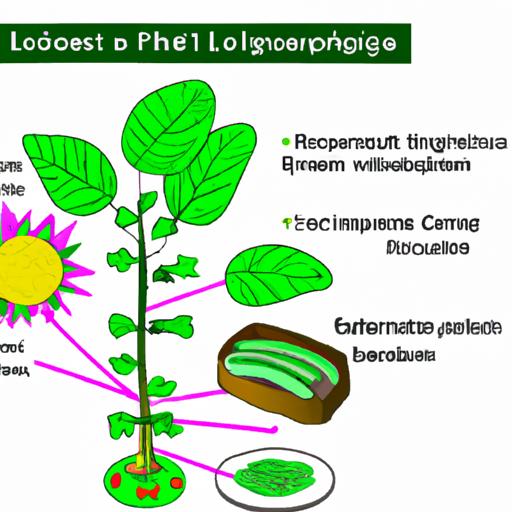Plants, the vibrant and awe-inspiring beings that grace our planet, possess a remarkable ability to harness energy. Have you ever wondered how these green wonders obtain the energy they need to grow, thrive, and contribute to our ecosystem? In this article, we will explore the captivating world of plant energy, delving into the intricate processes of photosynthesis and plant respiration.
Introduction
A. Definition and Importance of Plant Energy
Plant energy is the life force that fuels the growth, development, and sustenance of all plant species. It is the key element that enables plants to carry out essential functions, such as synthesizing organic compounds and maintaining cellular processes. Without energy, plants would be unable to convert sunlight into vital nutrients, impeding their ability to survive and flourish.
B. Overview of Photosynthesis and Plant Respiration
Photosynthesis and plant respiration are the two fundamental processes through which plants acquire and utilize energy. Photosynthesis, often hailed as the “ultimate energy converter,” enables plants to capture sunlight and convert it into chemical energy in the form of glucose. This process not only fuels the plant’s own growth but also serves as the foundation for the food chain, providing sustenance for countless organisms.
On the other hand, plant respiration is the mechanism by which plants unlock the stored energy within glucose molecules, releasing it for various metabolic activities. Through respiration, plants produce adenosine triphosphate (ATP), a molecule responsible for powering cellular functions and sustaining life processes.
Now that we have a glimpse of the captivating world of plant energy, let us dive deeper into the enchanting process of photosynthesis. Join me in the next section as we unravel the mysteries of how plants harness energy from sunlight, painting the world green with their vitality and splendor.
Photosynthesis: The Key to Plant Energy
A. Explanation of Photosynthesis Process
Photosynthesis, the remarkable process that drives the energy production in plants, is a fascinating symphony of chemical reactions. It occurs within specialized structures called chloroplasts, found in the leaves of plants. But how does this intricate process work?
During photosynthesis, plants utilize sunlight, water, and carbon dioxide to synthesize glucose, a sugar that serves as their primary energy source. Through a series of complex biochemical reactions, plants convert light energy into chemical energy, transforming the world around us.
B. Role of Chlorophyll in Capturing Sunlight
At the heart of photosynthesis lies chlorophyll, the pigment that gives plants their vibrant green color. Like tiny solar panels, chlorophyll molecules absorb sunlight, capturing its energy to fuel the photosynthetic process. It acts as nature’s own light-harvesting system, channeling the energy from photons into the chemical reactions that drive the synthesis of glucose.
C. Conversion of Sunlight into Chemical Energy
Once absorbed by chlorophyll, sunlight powers a cascade of reactions within the chloroplasts. These reactions involve the splitting of water molecules, releasing oxygen as a byproduct and generating high-energy electrons. These electrons are shuttled through a chain of proteins, creating a flow of energy that drives the synthesis of adenosine triphosphate (ATP), the universal energy currency of living organisms.
D. Generation of Glucose as the Primary Energy Source
As the photosynthetic process progresses, the energy derived from sunlight and the high-energy electrons are utilized to convert carbon dioxide into glucose. Glucose, a carbohydrate rich in energy, serves as the primary fuel for plants. It is stored within various plant parts, such as fruits, roots, and seeds, ensuring a constant supply of energy for growth, reproduction, and defense against environmental stressors.
Intriguing, isn’t it? The miracle of photosynthesis allows plants to transform sunlight into the life-sustaining energy they need to thrive. Join me in the next section as we uncover the factors that influence the efficiency of photosynthesis, shedding light on the intricate dance between plants and their environment.
Factors Affecting Photosynthesis Efficiency
A. Light Intensity and Its Impact on Energy Production
When it comes to photosynthesis, light plays a pivotal role in determining the efficiency of energy production. Plants rely on sunlight to drive the chemical reactions that convert carbon dioxide and water into glucose and oxygen. The intensity of light directly influences the rate at which these reactions occur.
Think about a sun-kissed field blanketed with a multitude of plants. As the sun’s rays pour down, the chlorophyll pigments within plant cells absorb the light, initiating the magical process of photosynthesis. But what happens when light becomes scarce? Photosynthesis slows down, and plant growth may be stunted. Similarly, excessive light can also be detrimental, as it can lead to the production of harmful reactive oxygen species.
B. The Significance of Temperature in Photosynthesis
Temperature, another crucial factor, can profoundly impact the efficiency of photosynthesis. Plants thrive within an optimal temperature range, typically between 65°F and 85°F (18°C and 30°C). At lower temperatures, the enzymatic reactions involved in photosynthesis slow down, hindering energy production. Conversely, excessively high temperatures can denature the enzymes, disrupting the delicate balance of photosynthetic processes.
Imagine a chilly morning where the air is crisp and frost glistens on leaves. Plants may struggle to photosynthesize efficiently in such conditions. On the other hand, scorching hot days may cause plants to wilt, as the excessive heat hampers their ability to convert light energy into chemical energy.
C. Importance of Carbon Dioxide Levels for Optimal Energy Production
Carbon dioxide, often referred to as the elixir of life for plants, is a vital component in the equation of optimal energy production. As carbon dioxide enters the plant through tiny pores called stomata, it becomes an essential ingredient for photosynthesis. Adequate levels of carbon dioxide enable plants to efficiently convert light energy into glucose, ensuring their growth and survival.
Consider the analogy of a baker preparing a delicious cake. Just as the baker requires the right amount of ingredients for a perfect outcome, plants need an optimal concentration of carbon dioxide for efficient photosynthesis. Insufficient carbon dioxide levels can limit the plant’s growth, while elevated levels can lead to enhanced photosynthetic rates, up to a certain threshold.
Understanding the interplay of light intensity, temperature, and carbon dioxide levels is crucial in unraveling the secrets of photosynthesis efficiency. Join me in the next section as we explore the fascinating realm of plant respiration, where stored energy is unlocked to fuel the plant’s vital functions.
Plant Respiration: Utilizing Stored Energy
Plant respiration, a vital process akin to breathing, plays a crucial role in unlocking the stored energy within plants. Let’s delve into the intricacies of plant respiration and discover how plants utilize the energy they have diligently synthesized through photosynthesis.
A. Introduction to Plant Respiration and Its Role
Plant respiration is an essential metabolic process that occurs in every living plant cell. Just like humans and animals, plants require energy to carry out various activities and maintain their physiological functions. Plant respiration serves as the gateway through which plants access the energy stored in glucose molecules, enabling them to thrive and flourish.
B. Overview of Aerobic Respiration Process
Aerobic respiration, the most common form of plant respiration, involves the breakdown of glucose in the presence of oxygen to produce energy. This process consists of three main stages: glycolysis, the Krebs cycle (also known as the citric acid cycle), and the electron transport chain. Each stage plays a crucial role in extracting energy from glucose and converting it into a usable form.
C. Conversion of Glucose into ATP for Energy Usage
During aerobic respiration, glucose is gradually broken down, releasing electrons that are captured by carrier molecules. These electrons then traverse the electron transport chain, generating adenosine triphosphate (ATP), the energy currency of cells. ATP provides the necessary fuel for various plant activities, including growth, reproduction, and defense against environmental stressors.
D. Release of Carbon Dioxide During Respiration
As plants respire, they not only release energy but also produce carbon dioxide (CO2) as a byproduct. This release of CO2 is a crucial component of the global carbon cycle, contributing to the balance of atmospheric gases. While plants absorb CO2 during photosynthesis, the process of respiration reverses this uptake, releasing CO2 back into the atmosphere.
Through the remarkable process of respiration, plants unlock the energy stored within glucose, fueling their growth and sustaining their existence in the intricate tapestry of life. In the upcoming sections, we will explore additional sources of plant energy and further unravel the secrets behind their vitality. Stay with me as we embark on this fascinating journey together.
Secondary Sources of Plant Energy
Plants are masterful in their ability to utilize not only sunlight but also secondary sources of energy to fuel their growth and vitality. These additional sources play a crucial role in providing plants with the nutrients and resources they need to thrive. Let’s explore some of these secondary sources of plant energy and uncover the fascinating ways in which they contribute to the plant’s overall well-being.
A. Role of Nutrients and Minerals in Plant Growth and Energy
Just as we require a balanced diet to stay healthy, plants rely on a diverse array of nutrients and minerals to support their growth and energy production. Elements such as nitrogen, phosphorus, and potassium, commonly known as NPK, are essential for plant development. Nitrogen aids in the synthesis of proteins and chlorophyll, while phosphorus supports energy transfer and DNA formation. Potassium, on the other hand, enhances water and nutrient uptake, contributing to overall plant vigor.
Beyond NPK, plants also require trace elements like iron, magnesium, and zinc, which act as catalysts for various biochemical reactions. These micronutrients, though required in smaller quantities, are equally vital for optimal plant growth and energy production.
B. Absorption of Water and Its Importance in Energy Production
Water, the elixir of life, serves as a vital source of energy for plants. Through their intricate root systems, plants absorb water from the soil, facilitating essential processes such as nutrient uptake and photosynthesis. Water not only provides structural support but also aids in the transportation of nutrients throughout the plant. Furthermore, during photosynthesis, water molecules are split, releasing oxygen and electrons that contribute to the generation of ATP, the energy currency of plant cells.
C. Symbiotic Relationships with Fungi for Enhanced Nutrient Uptake
Plants have forged remarkable symbiotic relationships with fungi, known as mycorrhizae, to enhance nutrient uptake and energy acquisition. These mutually beneficial partnerships enable plants to access nutrients, such as phosphorus and nitrogen, that may be otherwise inaccessible to them. The fungi extend their hyphae, or thread-like structures, into the soil, increasing the surface area available for nutrient absorption. In return, the plant provides the fungi with carbohydrates, the products of photosynthesis, establishing a harmonious exchange of resources.
By collaborating with fungi, plants tap into an expansive network that extends far beyond their root systems, expanding their access to vital nutrients and boosting their energy reserves.
As we uncover the fascinating secondary sources of plant energy, it becomes evident that plants are adept at harnessing diverse resources to fuel their growth. Join me in the next section as we draw the threads together and conclude our exploration of how plants obtain and utilize energy to thrive in their green kingdom.
Conclusion
In conclusion, understanding how plants obtain energy is a fascinating journey that unveils the intricate workings of nature’s powerhouses. Through the remarkable processes of photosynthesis and plant respiration, plants harness the energy they need to grow, reproduce, and contribute to the delicate balance of our ecosystem.
By capturing sunlight and converting it into chemical energy through photosynthesis, plants not only sustain themselves but also provide the foundation for life on Earth. The generation of glucose as the primary energy source enables plants to thrive and serve as a vital food source for herbivores, which in turn sustain carnivores and omnivores, creating a harmonious web of life.
Plant respiration, in turn, serves as the key to unlocking the stored energy within glucose molecules. The conversion of glucose into ATP fuels cellular processes, ensuring the vitality and survival of plants and their myriad interactions with the environment.
As we marvel at the wonders of plant energy, we are reminded of the intricate interconnectedness of all living beings. The delicate balance between plants, animals, and the environment highlights the importance of preserving and nurturing our natural world.
So, the next time you walk through a lush forest or admire a blooming garden, take a moment to appreciate the incredible energy that sustains these living wonders. Understanding how plants obtain energy allows us to appreciate the beauty and complexity of nature, inspiring us to protect and cherish the remarkable ecosystems that rely on the power of plants.
In this journey of discovery, we have barely scratched the surface. There is so much more to learn and explore about the extraordinary mechanisms through which plants acquire and utilize energy. Let us continue to delve into the mysteries of the natural world, awestruck by the wonders that unfold before us.
Remember, as we strive to unravel the secrets of plant energy, we are not just observers but active participants in the preservation and conservation of our planet. Together, let us celebrate and safeguard the remarkable energy that sustains life in all its forms.




